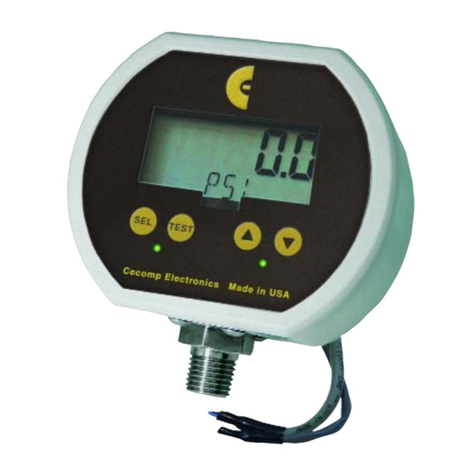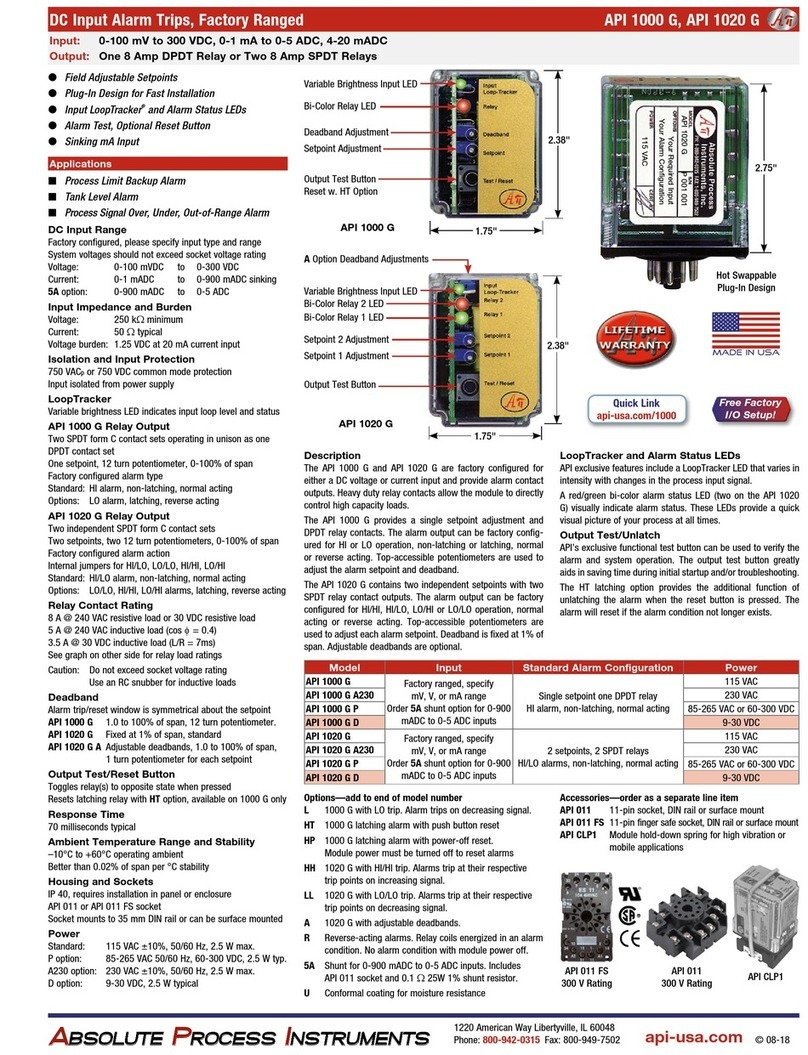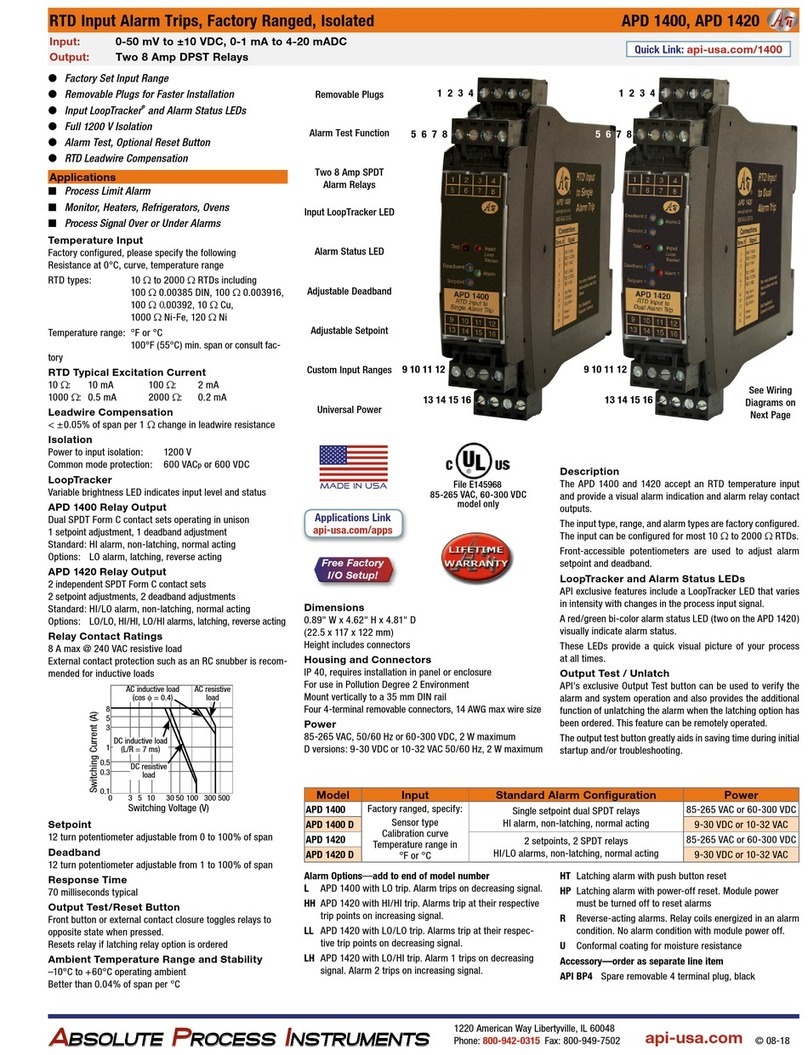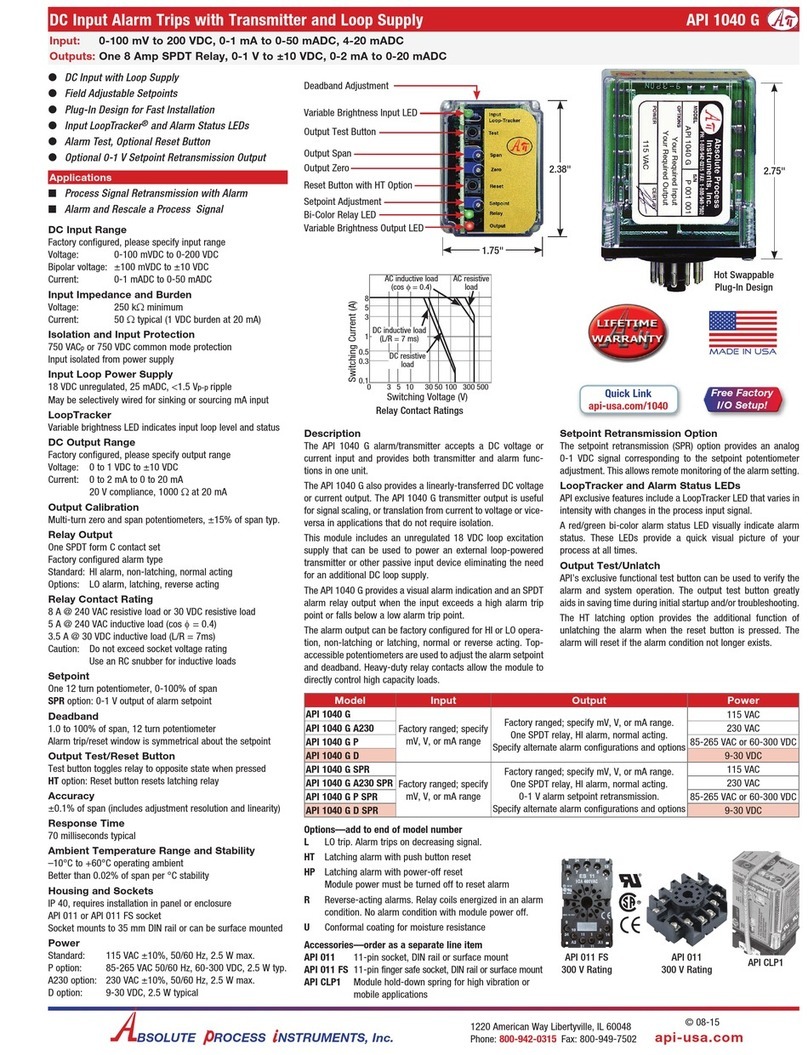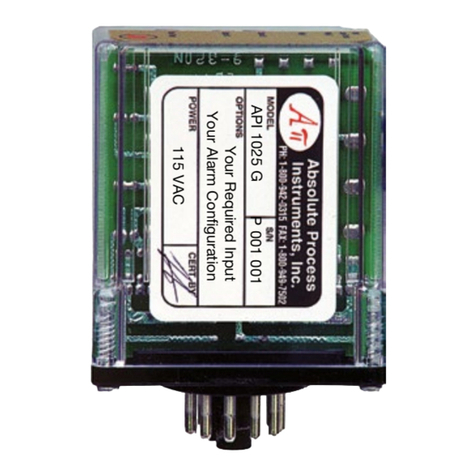
Precautions
WARNING! All wiring must be performed by a qualified electrician
or instrumentation engineer. See diagram for terminal designa-
tions and wiring examples. Consult factory for assistance.
WARNING! Avoid shock hazards! Turn signal input, output, and
power off before connecting or disconnecting wiring, or remov-
ing or installing module.
Précautions
ATTENTION! Tout le câblage doit être effectué par un élec-
tricien ou ingénieur en instrumentation qualifié. Voir le dia-
gramme pour désignations des bornes et des exemples de
câblage. Consulter l’usine pour assistance.
ATTENTION! Éviter les risques de choc! Fermez le signal
d’entrée, le signal de sortie et l’alimentation électrique avant
de connecter ou de déconnecter le câblage, ou de retirer ou
d’installer le module.
Range Selection
It is generally easier to select ranges before installation. See
the model/serial number label for module information, options,
or if a custom range was specified.
Set input selector switch A to "I" for a current input or to "V"
for a voltage input.
Switch settings B and C determine the input range.
Switch D determines the alarm configuration.
Socket and Mounting
Install module in a protective panel or enclosure. Use API 011
or finger-safe API 011 FS socket. See specifications for maxi-
mum allowable socket voltages. The socket clips to a standard
35 mm DIN rail or can be attached to a flat surface using the
two mounting holes.
Signal Input Terminals
See wiring diagrams below. Polarity must be observed for input
wiring connections. If the input does not function, check switch
settings and wiring polarity.
The milliamp input can be used with either sinking or sourcing
mA transmitters. Determine if your transmitter provides power
to the current loop or if it must be powered by the API module.
Only one device must provide power to the current loop. Use
a multi-meter to check for voltage at the transmitter's output
terminals. Typical voltage may be in the range of 9 to 24 VDC.
In this case, wire the device to terminals 4 and 5.
Relay Output Terminals
See wiring diagrams below. API modules do not provide power
to the relay contacts. Inductive loads (motors, solenoids, con-
tactors, etc.) will greatly shorten relay contact life unless an
appropriate RC snubber is installed.
Module Power Terminals
Check model/serial number label for module operating voltage
to make sure it matches available power.
When using DC power, polarity must be observed. Wire (+) to
terminal 1 and negative (–) to terminal 3.
Setpoint
This multi-turn potentiometer (one for each setpoint on the API
1090 G) allows the operator to adjust the level at which the
alarm is activated. This control is adjustable from 0 to 100%
of the input range.
Deadband
The deadband potentiometer (one for each setpoint on the API
1090 G) allows the alarm trip/reset window to be adjusted
symmetrically about the setpoint from 1 to 100% of the span.
Deadband allows the operator to fine tune the point at which
the alarm trips and resets. The deadband is typically used to
prevent chattering of the relays or false trips when the process
signal is unstable or changes rapidly.
Adjustments
To calibrate the alarm section, set the deadband control to
the minimum (counterclockwise). The deadband will be 1% of
input span in this case.
Set the signal source to a reference that represents the desired
trip point.
Adjust the setpoint control to the point at which the relay
changes state from a non-alarm to an alarm condition.
If a larger amount of deadband is desired turn the deadband
potentiometer clockwise. The deadband is symmetrical about
the setpoint; both transition points will change as deadband
is increased.
Alternately set the setpoint and deadband until the desired trip/
reset points are set.
The adjustment procedure needs to be repeated any time
switch settings are changed.
Output Test / Latching Function
When the test button is depressed it will drive the relays to
their opposite state. This can be used as a diagnostic aid during
initial start-up or troubleshooting. When released, the relays
will return to their prior states.
When the latching mode is selected, it will be necessary to
push the output test button or remove power from the module
to reset the alarm. The alarm will only reset if the alarm condi-
tion no longer exists.
Operation
The green LoopTracker®input LED provides a visual indication
that a signal is being sensed by the input circuitry of the mod-
ule. It also indicates the input signal strength by changing in
intensity as the process changes from minimum to maximum.
If the LED fails to illuminate, or fails to change in intensity as
the process changes, check the module power or signal input
wiring. Note that it may be difficult to see the LEDs under bright
lighting conditions.
The bi-color alarm LED provides a visual indication of the alarm
status. In all configurations, a green LED indicates a non-alarm
condition and a red LED indicates an alarm condition.
High Alarm
The alarm relay changes state when the input exceeds the
deadband trip point. The relay resets when the input drops
below the deadband reset point unless latching is enabled. For
a high alarm, the trip point is above the reset point.
Low Alarm
The alarm relay changes state when the input goes below the
deadband trip point. The relay resets when the input exceeds
the deadband reset point unless latching is enabled. For a low
alarm, the trip point is below the reset point.
Latching
In this mode the alarm latches when an alarm occurs. The Test
button or powering the module off can be used to reset the
alarm provided the alarm condition no longer exists.
Normal Acting Alarms
Normal acting alarms energize the relay coils in a non-alarm
condition and de-energize them in an alarm condition. This will
create an alarm condition if the module loses power.
Reverse Acting Alarms
Reverse-acting alarms energize the relay coils in an alarm con-
dition and de-energize them in a non-alarm condition. There is
no alarm condition with module power off.
Installation and Setup API 1080 G, API 1090 G
4
C
0
8
E
2
A
6
3
F
B
7
5
9
D
1
I V
Input
Select
4
C
0
8
E
2
A
6
3
F
B
7
5
9
D
1
Input
Attenu-
ation
Input
Offset
Alarm
Config.
1. Set input selector switch to either (V)
Voltage or (I) Current as required.
2. From input table, set switches B and C
for specific input range.
3. From alarm configuration table set switch D
for specific alarm action required.
A B C D
1080G
0
5
1
6
4
2
9
7
3
8
4
C
0
8
E
2
A
6
3
F
B
7
5
9
D
1
4
C
0
8
2
A
6
3
F
B
7
5
9
D
1
I V
Input
Select
4
C
0
8
E
2
A
3
F
B
7
5
9
D
1
Input
Attenu-
ation
Input
Offset
Alarm
Config.
1. Set input selector switch to either (V)
Voltage or (I) Current as required.
2. From input table, set switches B and C
for specific input range.
3. From alarm configuration table set switch D
for specific alarm action required.
A B C D
1090G
6
E
API 1080 G Alarm States with Normal Action HI Alarm
Relay 1
8NC
7Common
6NO
Relay 2
11 NC
10 Common
9NO
GREEN
No Alarm RED
HI Alarm
Relay 1
8NC
7Common
6NO
Relay 2
11 NC
10 Common
9NO
API 1090 G Alarm States with Normal Action HI/LO Alarms
No Alarm
GREEN Relay 1
8NC
7Com.
6NO
Relay 2
11 NC
10 Com.
9NO
GREEN GREEN
Relay 1
8NC
7Com.
6NO
Relay 2
11 NC
10 Com.
9NO
RED
HI Alarm LO Alarm
GREEN Relay 1
8NC
7Com.
6NO
Relay 2
11 NC
10 Com.
9NO
RED
32111109
87654
(–) (+)
AC or
DC–
AC or
DC+
Contact Set 1
NC C NO
Module power
Socket
top view
Key down
when panel
mounting
See
api-usa.com/accessories
for socket information
and dimensions
Passive
mA
SignalRi
Terminals 2 and 4 provide
18 V loop power for a
passive mA input
Input
(+)
18 VDC
NO = Normally Open
C = Common
NC = Normally Closed
(–) (+)
5 4
Input
Voltage
or Sourcing
mA Signal
Use terminals 4 and 5 for
a voltage input or mA input
from a sourcing transmitter
NO C NC
Contact Set 2
API maintains a constant effort to upgrade and improve its products.
Specifications are subject to change without notice. See api-usa.com for
latest product information. Consult factory for your specific requirements.
WARNING: This product can expose you to chemicals includ-
ing lead and nickel, which are known to the State of California
to cause cancer or birth defects or other reproductive harm.
For more information go to www.P65Warnings.ca.gov
Input
Range
Switch API 1080 G Alarm Settings
A B C SP1 Latch Action D
0-50 mV V81 HI No Normal 2
0-100 mV V91 HI No Reverse 6
0-200 mV VA1 HI Yes Normal 0
0-250 mV VC1 HI Yes Reverse 4
0-400 mV VB1 LO No Normal 3
0-500 mV V01 LO No Reverse 7
±50 mV* VA4 LO Yes Normal 1
±100 mV* VB4 LO Yes Reverse 5
0-1 V V11
0-2 V V21 API 1090 G Alarm Settings
0-2.5 V V41 SP1 SP2 Latch Action D
0-4 V V31 HI LO No Normal 6
1-5 V V5F HI LO No Reverse E
0-5 V V51 HI LO Yes Normal 2
0-10 V V61 HI LO Yes Reverse A
±5 V V64 HI HI No Normal 4
±10 V V74 HI HI No Reverse C
0-1 mA IC1 HI HI Yes Normal 0
0-2 mA I01 HI HI Yes Reverse 8
0-4 mA I11 LO LO No Normal 7
0-8 mA I21 LO LO No Reverse F
2-10 mA I2F LO LO Yes Normal 3
0-10 mA I41 LO LO Yes Reverse B
0-16 mA I31 LO HI No Normal 5
0-20 mA I51 LO HI No Reverse D
4-20 mA I5F LO HI Yes Normal 1
* AP1090 G only LO HI Yes Reverse 9
